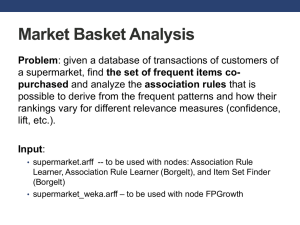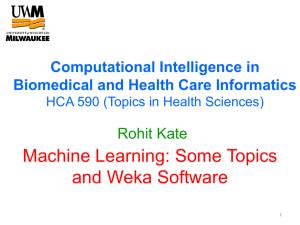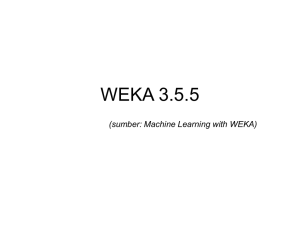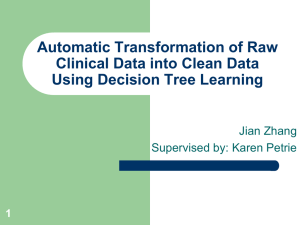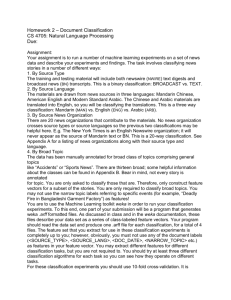Data
advertisement
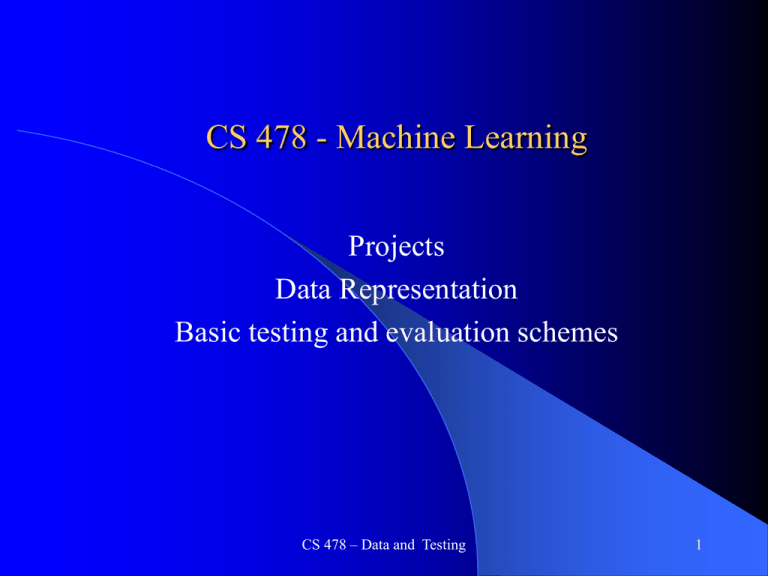
CS 478 - Machine Learning
Projects
Data Representation
Basic testing and evaluation schemes
CS 478 – Data and Testing
1
Programming Issues
Program in any platform you want
Realize that you will be doing actual training which can be
more time-consuming if implemented in an inefficient way
or with an inefficient platform
We will supply a basic ML toolkit in either C++ or Java
You are welcome to create your own toolkit if you would
like, but you need to have at least the level of functionality
as in the supplied versions
Details found at
http://axon.cs.byu.edu/~martinez/classes/478/stuff/Toolkit.
html
CS 478 – Data and Testing
2
Machine Learning Toolkit
The CS 478 tool kit is intended as a starting place for working
with machine learning algorithms. It provides the following
functionality to run your algorithms:
– Parses and stores the ARFF file (ARFF is the data set format we will
–
–
–
–
use)
Randomizes the instances in the ARFF file
Allows normalization of attributes
Parses command line arguments
Provides four evaluation methods:
Training set method: The model is evaluated on the same data set that was
used for training
Static split test set method: Two distinct data sets are made available to the
learning algorithm; one for training and one for testing
Random split test set method: A single data set is made available to the
learning algorithm and the data set is split such that x% of the instances are
randomly selected for training and the remainder are used for testing, where
you supply the value of x.
N-fold cross-validation
– Allows selection of which ML model to train and test with
– Ability to report training and accuracy information (training and test set
accuracies, learning time, etc.)
CS 478 – Data and Testing
3
Gathering a Data Set
Consider a Task: Classifying the quality of pizza
What features might we use?
Data Types
– Nominal (aka Categorical, Discrete)
– Continuous (aka Real, Numeric)
– Linear (aka Ordinal) – Is usually just treated as continuous, so that
ordering info is maintained
How to represent those features?
– Will usually depend on the learning model we are using
Classification assumes the output class is nominal. If
output is continuous, then we are doing regression.
CS 478 – Data and Testing
4
Fitting Data to the Model
Continuous -> Nominal
– Discretize into bins – more on this later
Nominal -> Continuous (Perceptron expects continuous)
a) One input node for each nominal value where one of the nodes is
set to 1 and the other nodes are set to 0
Can also explode the variable into n-1 input nodes where the most
common value is not explicitly represented (i.e. the all 0 case)
b) Use 1 node but with a different continuous value representing each
nominal value
c) Distributed – logbn nodes can uniquely represent n nominal values
(e.g. 3 binary nodes could represent 8 values)
d) If there is a very large number of nominal values, could cluster
(discretize) them into a more manageable number of values and
then use one of the techniques above
CS 478 – Data and Testing
5
Data Normalization
What would happen if you used two input features in an
astronomical task as follows:
– Weight of the planet in grams
– Diameter of the planet in light-years
CS 478 – Data and Testing
6
Data Normalization
What would happen if you used two input features in an
astronomical task as follows:
– Weight of the planet in grams
– Diameter of the planet in light-years
Normalize the Data between 0 and 1 (or similar bounds)
– For a specific instance, could get the normalized feature as follows:
fnormalized = (foriginal - MinvalueTS )/(MaxvalueTS - MinvalueTS )
Use these same Max and Min values to normalize data in
novel instances
Note that a novel instance may have a normalized value
outside 0 and 1
– Why? Is it a big issue?
CS 478 – Data and Testing
7
ARFF Files
An ARFF (Attribute-Relation File Format) file is an ASCII text
file that describes a Machine Learning dataset (or relation).
– Developed at the University of Waikato (NZ) for use with the Weka
machine learning software (http://www.cs.waikato.ac.nz/~ml/weka).
– We will use the ARFF format for CS 478
ARFF files have two distinct sections:
– Metadata information
Name of relation (Data Set)
List of attributes and domains
– Data information
Actual instances or rows of the relation
Optional comments may also be included which give information
about the Data Set (lines prefixed with %)
CS 478 – Data and Testing
8
Sample ARFF File
% 1. Title: Pizza Database
% 2. Sources:
% (a) Creator: BYU CS 478 Class…
%
(b) Statistics about the features, etc.
@RELATION Pizza
@ATTRIBUTE Weight
@ATTRIBUTE Crust
@ATTRIBUTE Cheesiness
@ATTRIBUTE Meat
@ATTRIBUTE Quality
CONTINUOUS
{Thick, Thin, Stuffed}
CONTINUOUS
{True, False}
{Great, Good, Fair}
@DATA
.9,
Stuffed,
.1,
Thin,
?,
Thin,
.6,
Thick,
True,
False,
True,
True,
99,
2,
60,
60,
Great
Fair
Good
Great
Any column could be the output, but we will assume that the last
column(s) is the output
What would you do to this data before using it with a perceptron and
what would the perceptron look like?
CS 478 – Data and Testing
9
ARFF Files
More details and syntax information for ARFF files can be
found at our website
Data sets that we have already put into the ARFF format
can also be found at our website
http://axon.cs.byu.edu/data/
You will use a number of these in your simulations
throughout the semester – Always read about the task,
features, etc, rather than just plugging in the numbers
You will create your own ARFF files in some projects, and
particularly with the group project
CS 478 – Data and Testing
10
Performance Measures
There are a number of ways to measure the performance of
a learning algorithm:
– Predictive accuracy of the induced model
– Size of the induced model
– Time to compute the induced model
– etc.
We will focus here on accuracy
Fundamental Assumption:
Future novel instances are drawn from the same/similar
distribution as the training instances
CS 478 – Data and Testing
11
Toolkit Training/Testing Alternatives
Four methods that we will use with our Toolkit:
– Training set method: The model is evaluated on the same
data set that was used for training
– Static split test set method: Two distinct data sets are made
available to the learning algorithm; one for training and one
for testing
– Random split test set method: A single data set is made
available to the learning algorithm and the data set is split
such that x% of the instances are randomly selected for
training and the remainder are used for testing, where you
supply the value of x.
– N-fold cross-validation
CS 478 – Data and Testing
12
Training Set Method
Procedure
– Build model from the dataset
– Compute accuracy on the same dataset
Simple but least reliable estimate of future performance on
unseen data (a rote learner could score 100%!)
Not used as a performance metric but it is often useful
information in understanding how a machine learning
model learns
This is information which you will typically report in your
write-ups and then compare it with how the learner does on
a test set, etc.
CS 478 – Data and Testing
13
Static Training/Test Set
Static Split Approach
– The data owner makes available to the machine learner two distinct
datasets:
One is used for learning/training (i.e., inducing a model), and
One is used exclusively for testing
Note that this gives you a way to do repeatable tests
Can be used for challenges (e.g. to see how everyone does
on one particular unseen set, etc.)
Be careful not to overfit the Test Set (“Gold Standard”)
CS 478 – Data and Testing
14
Random Training/Test Set Approach
Random Split Approach
– The data owner makes available to the machine learner a single dataset
– The machine learner splits the dataset into a training and a test set, such
that:
–
–
–
–
Instances are randomly assigned to either set
The distribution of instances (with respect to the target class) is hopefully
similar in both sets due to randomizing the data before the split (stratification
is even better but not required here)
Typically 60% to 90% of instances are used for training and the remainder for
testing – the more data there is the more that can be used for training and still
get statistically significant test predictions
Useful quick estimate for computationally intensive learners
Not statistically optimal (high variance, unless lots of data)
Can avoid possible overfit of just one test set
Best to do multiple training runs with different splits. Train and test m
times and then average the accuracy over the m runs to get a more
statistically accurate prediction of generalization accuracy
CS 478 – Data and Testing
15
N-fold Cross-validation
Use all the data for both training and testing
– Statistically more reliable
– All data can be used which is good for small data sets
Procedure
– Partition the randomized dataset (call it D) into N equally-
sized subsets S1, …, SN
– For k = 1 to N
Let Mk be the model induced from D - Sk
Let ak be the accuracy of Mk on the instances of the test
fold Sk
– Return (a1+a2+…+aN)/N
CS 478 – Data and Testing
16
N-fold Cross-validation (cont.)
The larger N is, the smaller the variance in the final result
The limit case where N = |D| is known as leave-one-out
and provides the most reliable estimate. However, it is
typically only practical for small instance sets
Generally, a value of N=10 is considered a reasonable
compromise between time complexity and reliability
Still must chose an actual model to use during execution how?
– Could select the one model that was best on its fold?
– All data? With any of the above approaches
Note that CV is just a better way to estimate how well we
will do on novel data, rather than a way to do model
selection
CS 478 – Data and Testing
17
Perceptron/Regression Project
http://axon.cs.byu.edu/~martinez/classes/478/Assignments.ht
ml
Also briefly review group project proposal part
CS 478 – Data and Testing
18
Your Project Proposals
Come up with one carefully proposed idea for a possible group machine learning
project, that could be done this semester. This proposal should not be more than one
page long. It should include a thoughtful first draft proposal of a) description of the
project, b) what features the data set would include and c) how and from where would
the data set be gathered and labeled. Give at least one fully specified example of a data
set instance based on your proposed features, including a reasonable representation
(continuous, nominal, etc.) and value for each feature. The actual values may be
fictional at this time. This effort will cause you to consider how plausible the future
data gathering and representation might actually be.
Examples – Irvine Data Set to get a feel
– Stick with supervised classification data sets for the most part
Tasks which interest you
Too hard vs Too Easy
– Data can be gathered in a relatively short time
– Want you to have to battle with the data/features a bit
CS 478 - Feature Selection and Reduction
19
